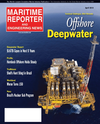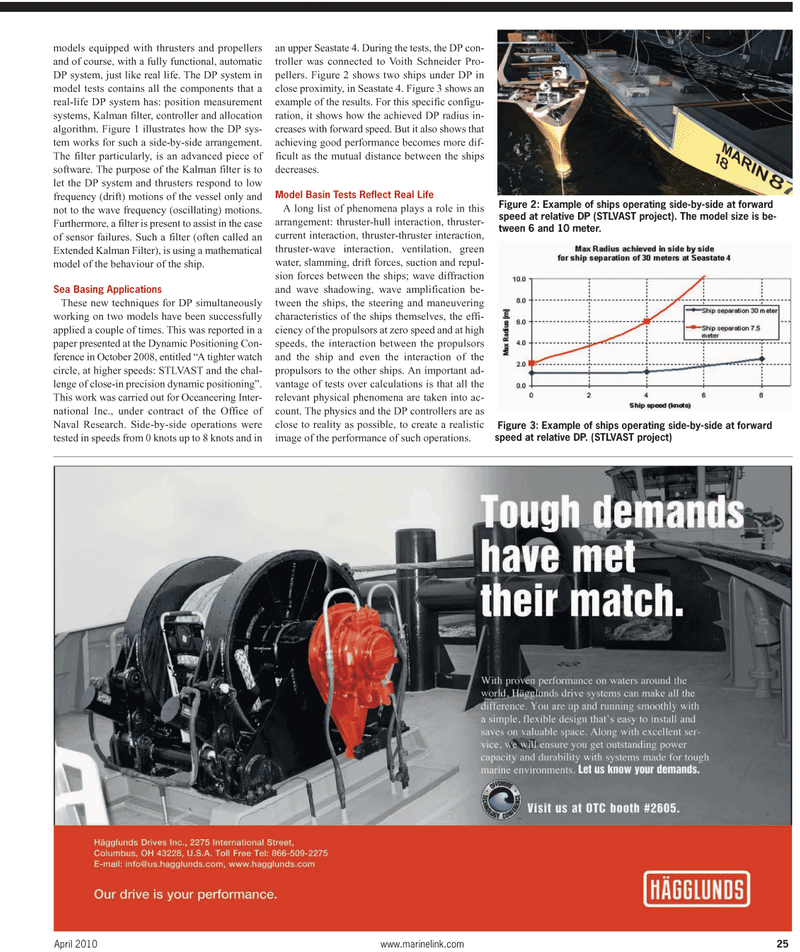
Page 25: of Maritime Reporter Magazine (April 2, 2010)
Read this page in Pdf, Flash or Html5 edition of April 2, 2010 Maritime Reporter Magazine
April 2010 www.marinelink.com 25 models equipped with thrusters and propellers and of course, with a fully functional, automatic
DP system, just like real life. The DP system in model tests contains all the components that a real-life DP system has: position measurement systems, Kalman filter, controller and allocation algorithm. Figure 1 illustrates how the DP sys- tem works for such a side-by-side arrangement.
The filter particularly, is an advanced piece of software. The purpose of the Kalman filter is to let the DP system and thrusters respond to low frequency (drift) motions of the vessel only and not to the wave frequency (oscillating) motions.
Furthermore, a filter is present to assist in the case of sensor failures. Such a filter (often called an
Extended Kalman Filter), is using a mathematical model of the behaviour of the ship.
Sea Basing Applications
These new techniques for DP simultaneously working on two models have been successfully applied a couple of times. This was reported in a paper presented at the Dynamic Positioning Con- ference in October 2008, entitled “A tighter watch circle, at higher speeds: STLVAST and the chal- lenge of close-in precision dynamic positioning”.
This work was carried out for Oceaneering Inter- national Inc., under contract of the Office of
Naval Research. Side-by-side operations were tested in speeds from 0 knots up to 8 knots and in an upper Seastate 4. During the tests, the DP con- troller was connected to Voith Schneider Pro- pellers. Figure 2 shows two ships under DP in close proximity, in Seastate 4. Figure 3 shows an example of the results. For this specific configu- ration, it shows how the achieved DP radius in- creases with forward speed. But it also shows that achieving good performance becomes more dif- ficult as the mutual distance between the ships decreases.
Model Basin Tests Reflect Real Life
A long list of phenomena plays a role in this arrangement: thruster-hull interaction, thruster- current interaction, thruster-thruster interaction, thruster-wave interaction, ventilation, green water, slamming, drift forces, suction and repul- sion forces between the ships; wave diffraction and wave shadowing, wave amplification be- tween the ships, the steering and maneuvering characteristics of the ships themselves, the effi- ciency of the propulsors at zero speed and at high speeds, the interaction between the propulsors and the ship and even the interaction of the propulsors to the other ships. An important ad- vantage of tests over calculations is that all the relevant physical phenomena are taken into ac- count. The physics and the DP controllers are as close to reality as possible, to create a realistic image of the performance of such operations.
Figure 2: Example of ships operating side-by-side at forward speed at relative DP (STLVAST project). The model size is be- tween 6 and 10 meter.
Figure 3: Example of ships operating side-by-side at forward speed at relative DP. (STLVAST project)

 24
24

 26
26
